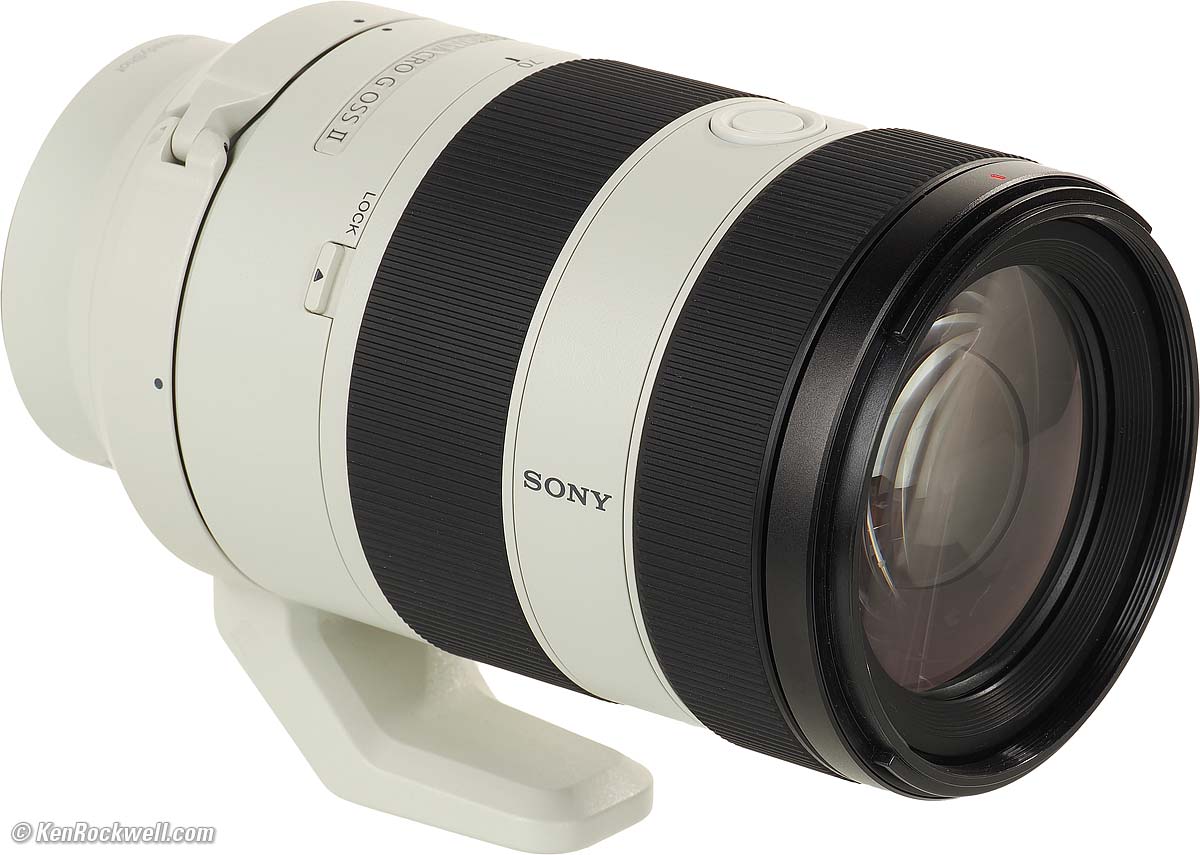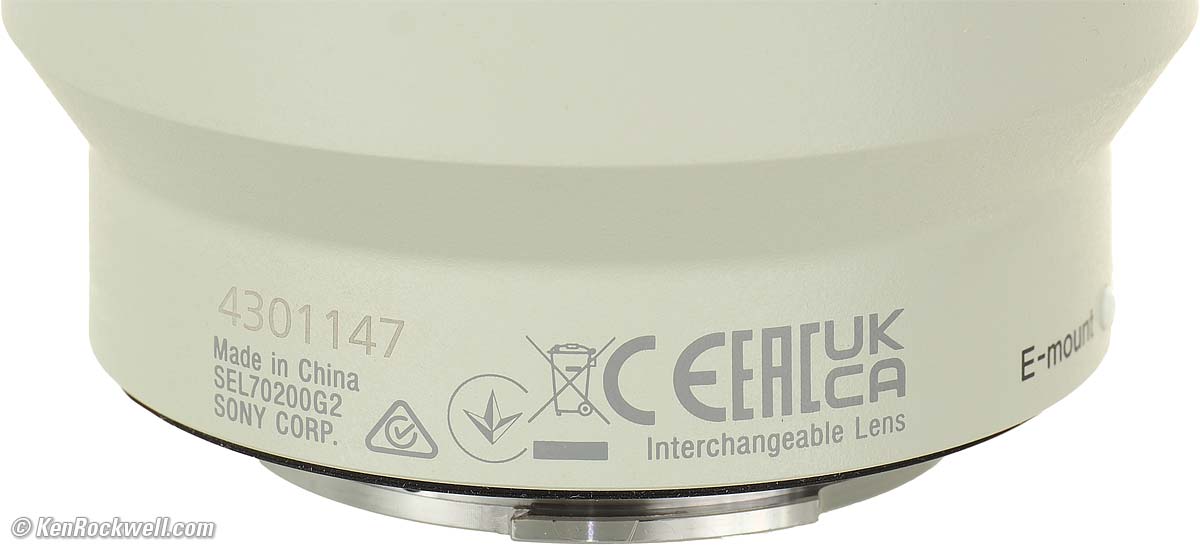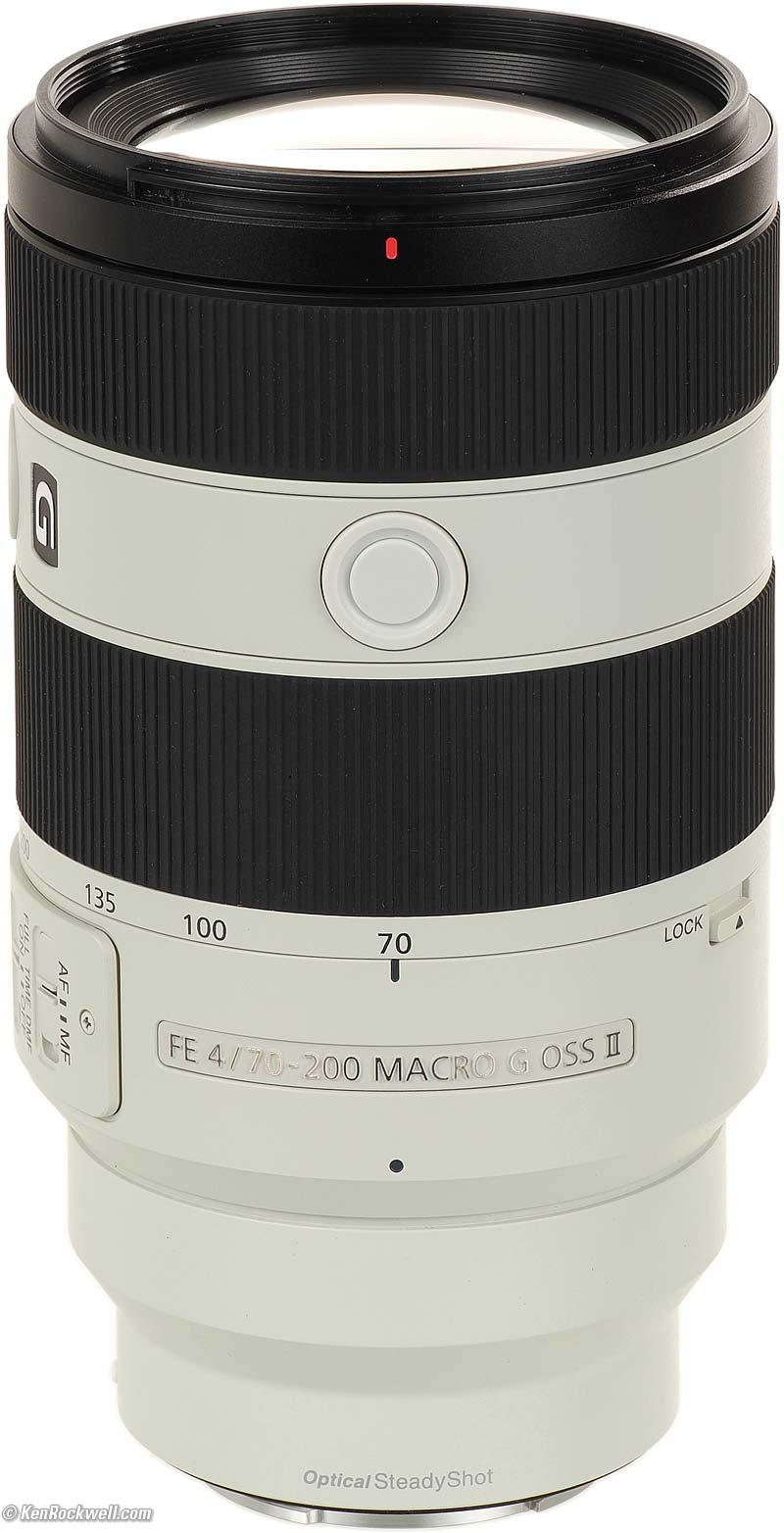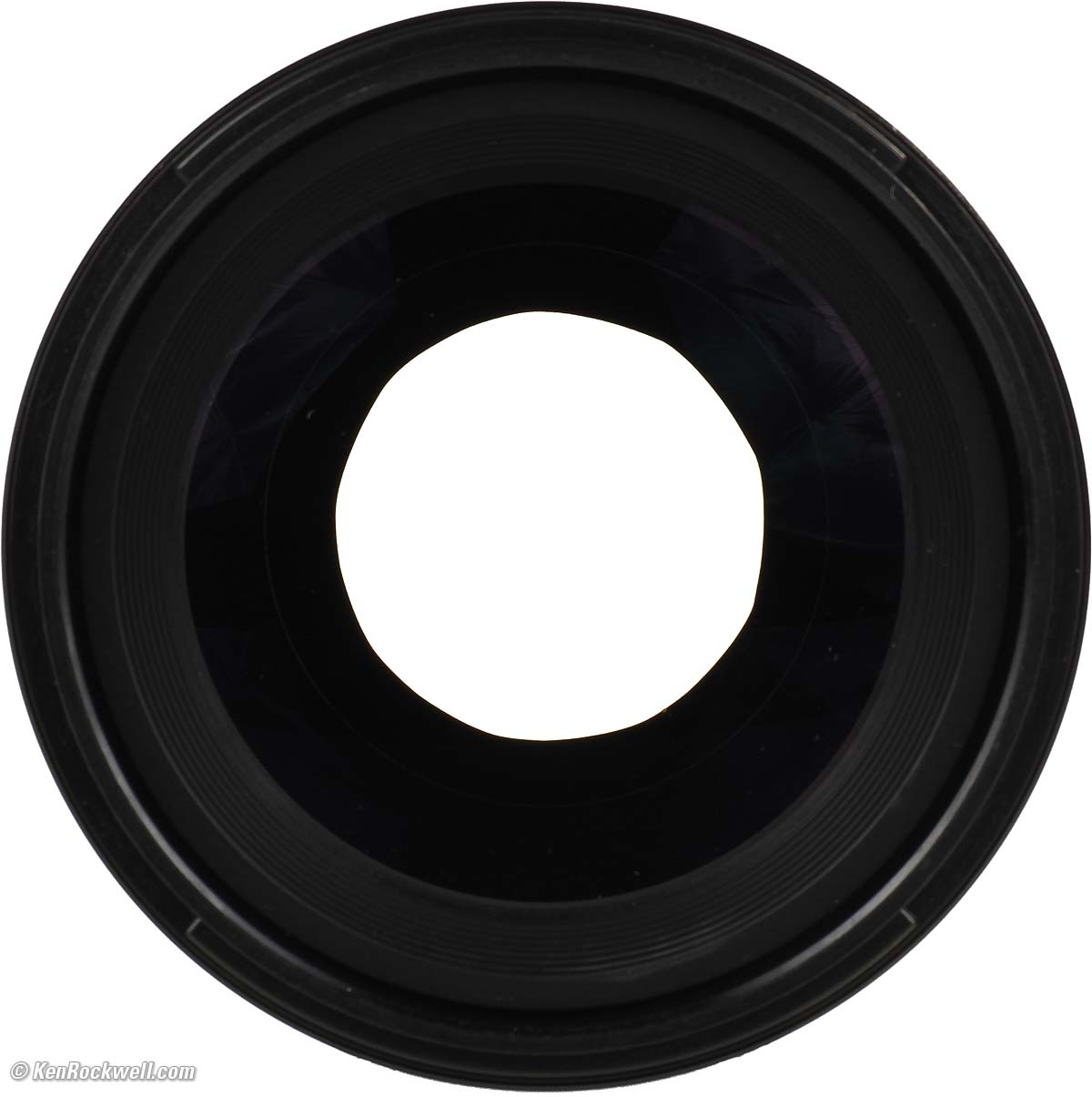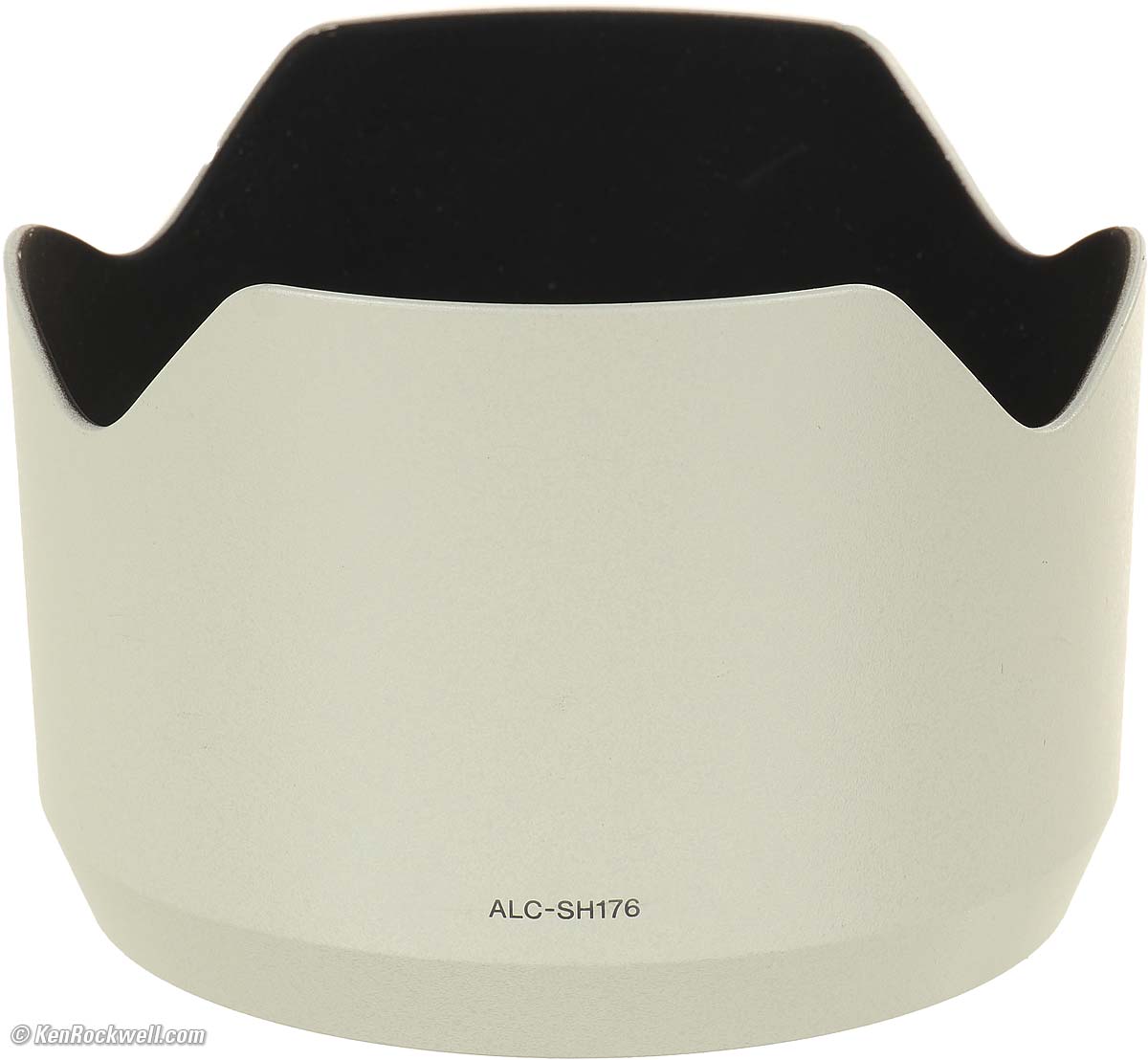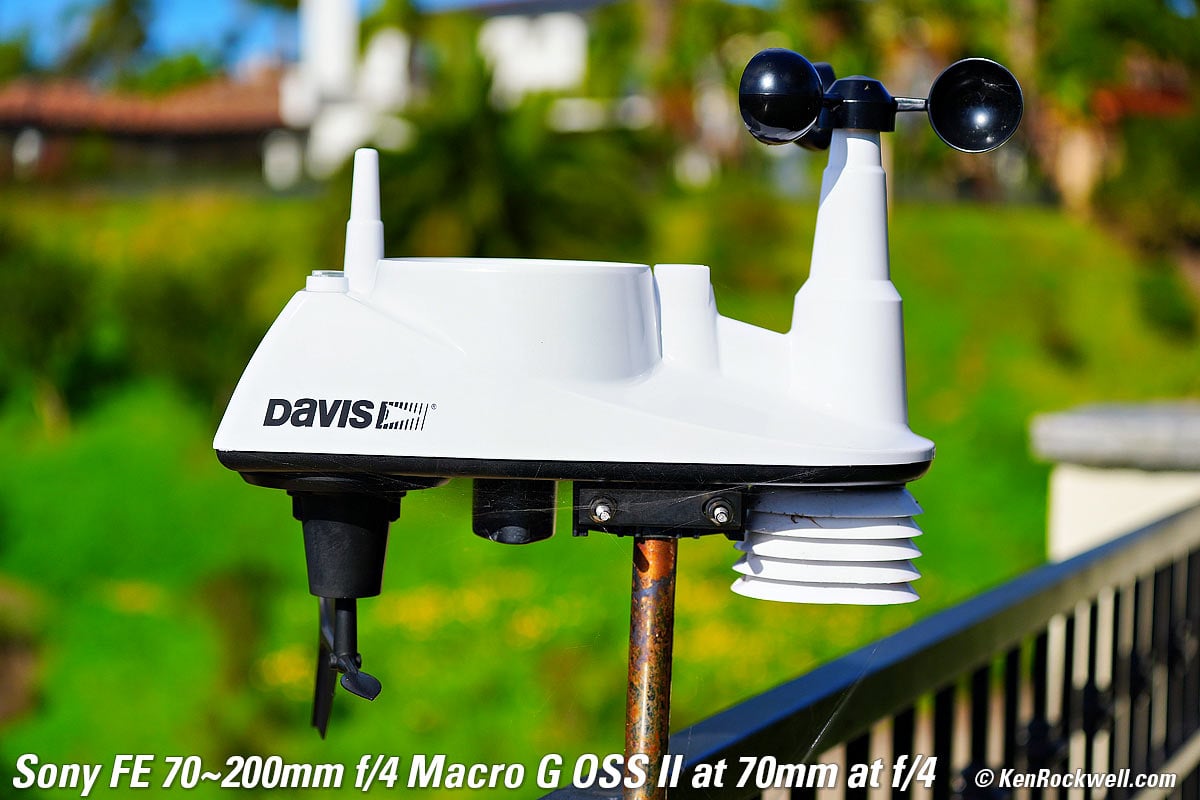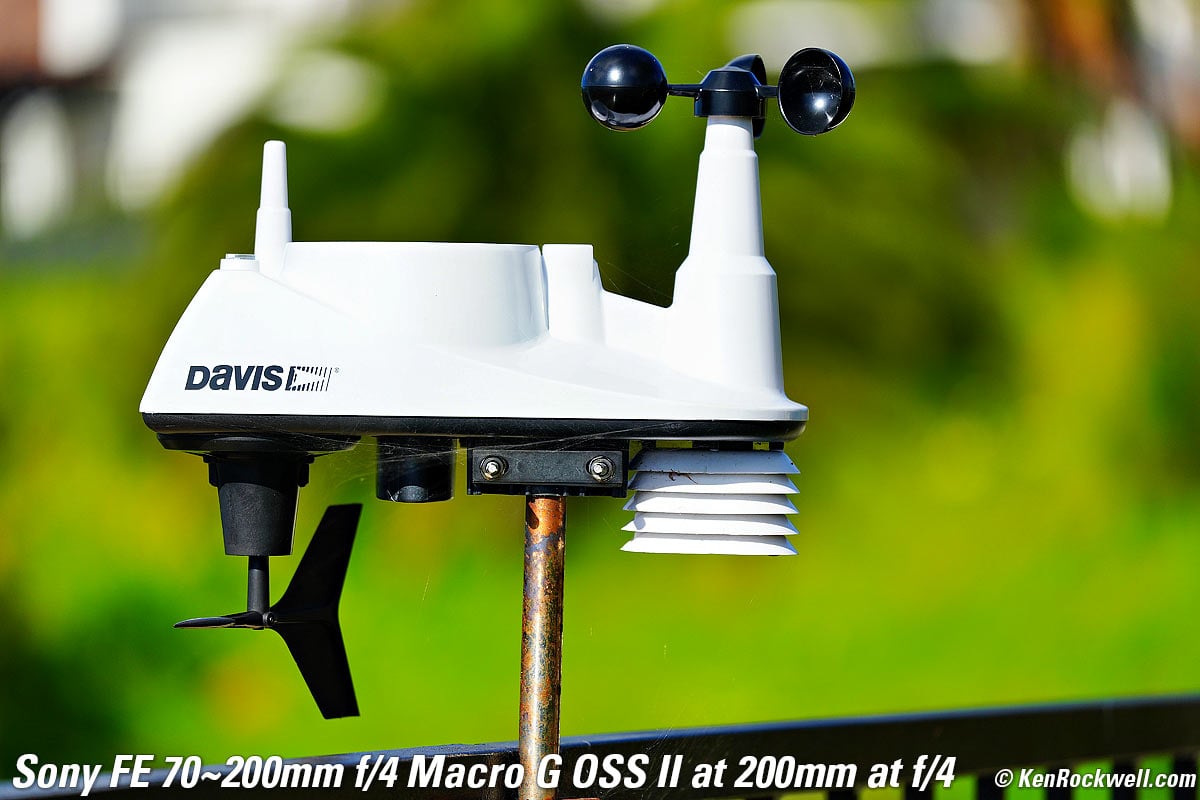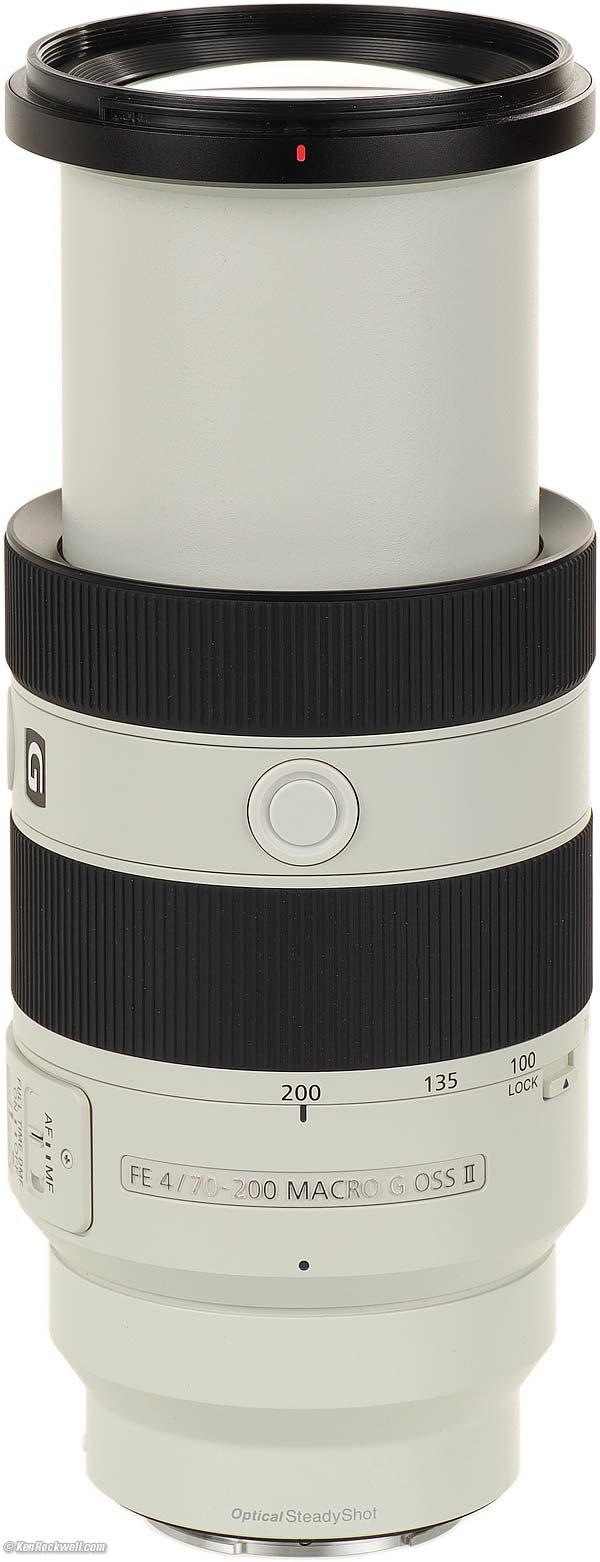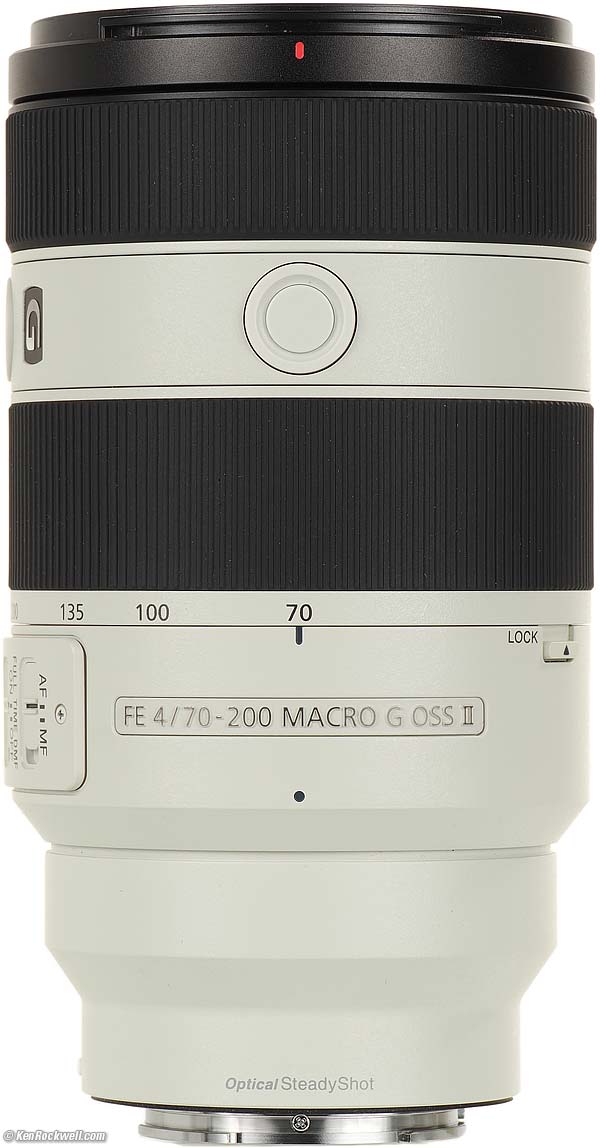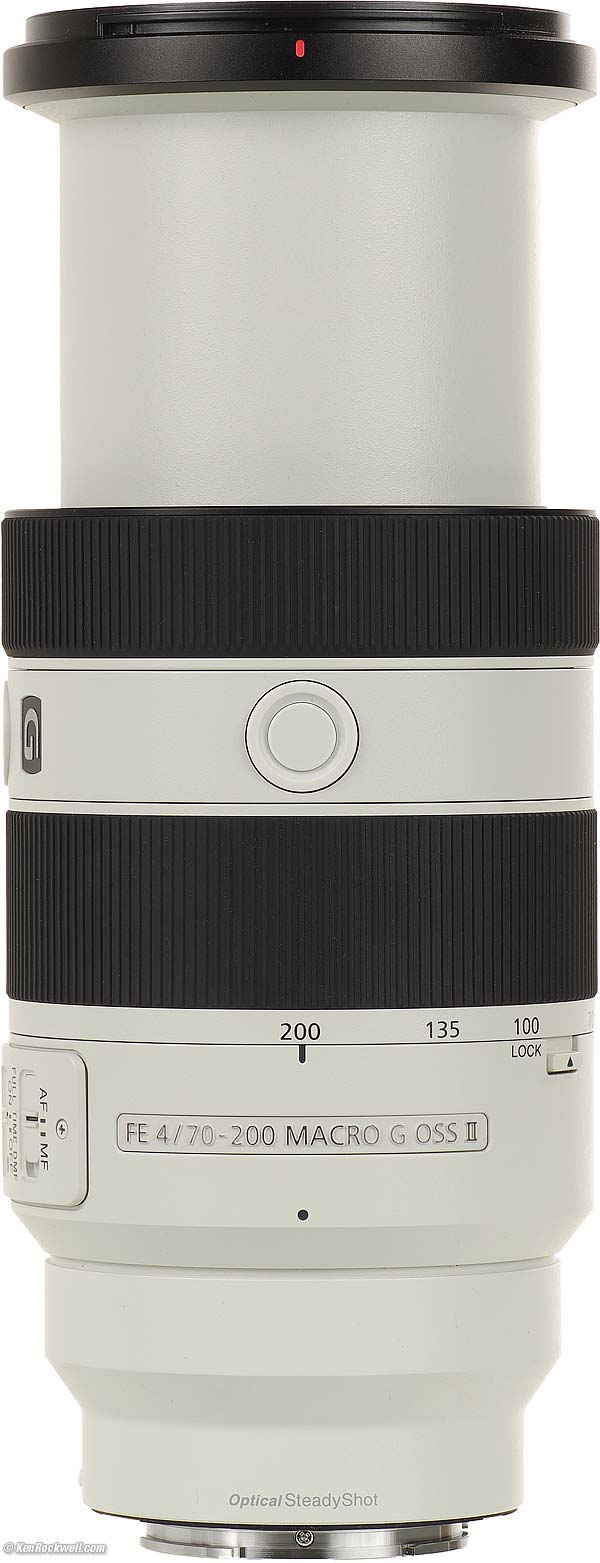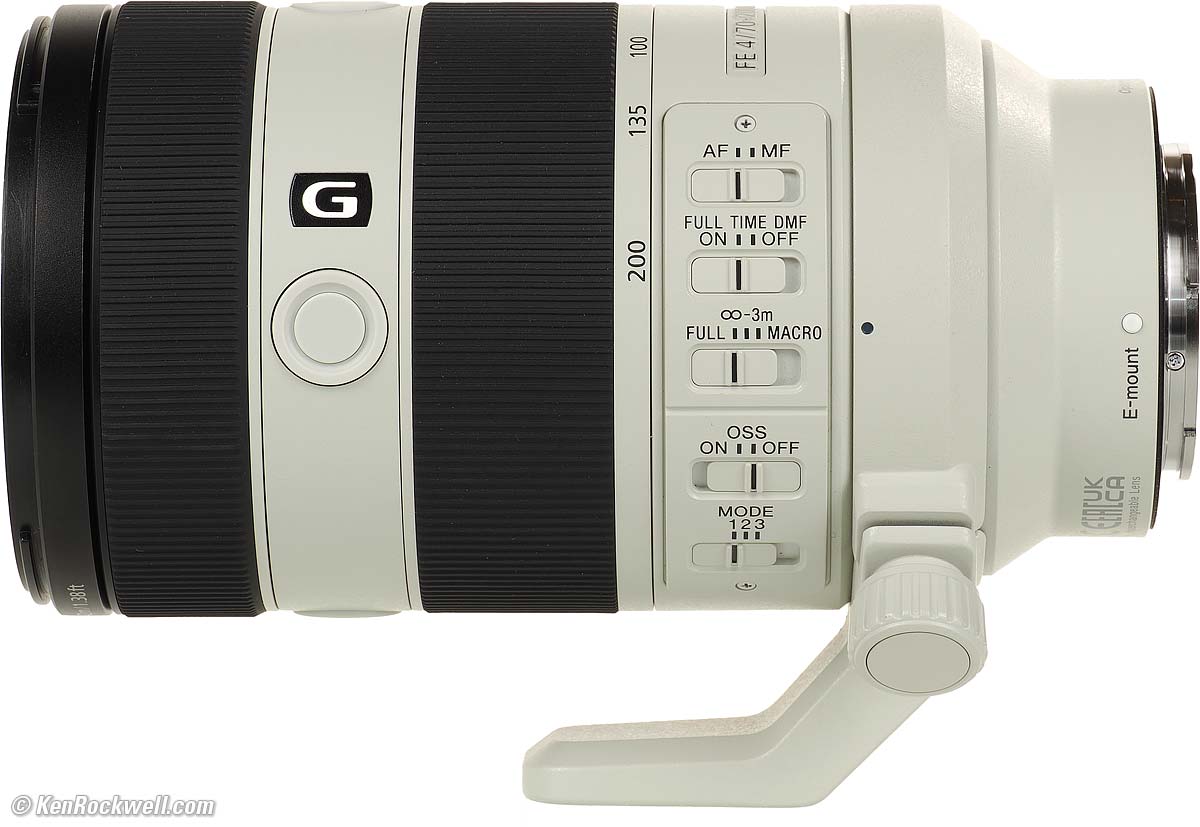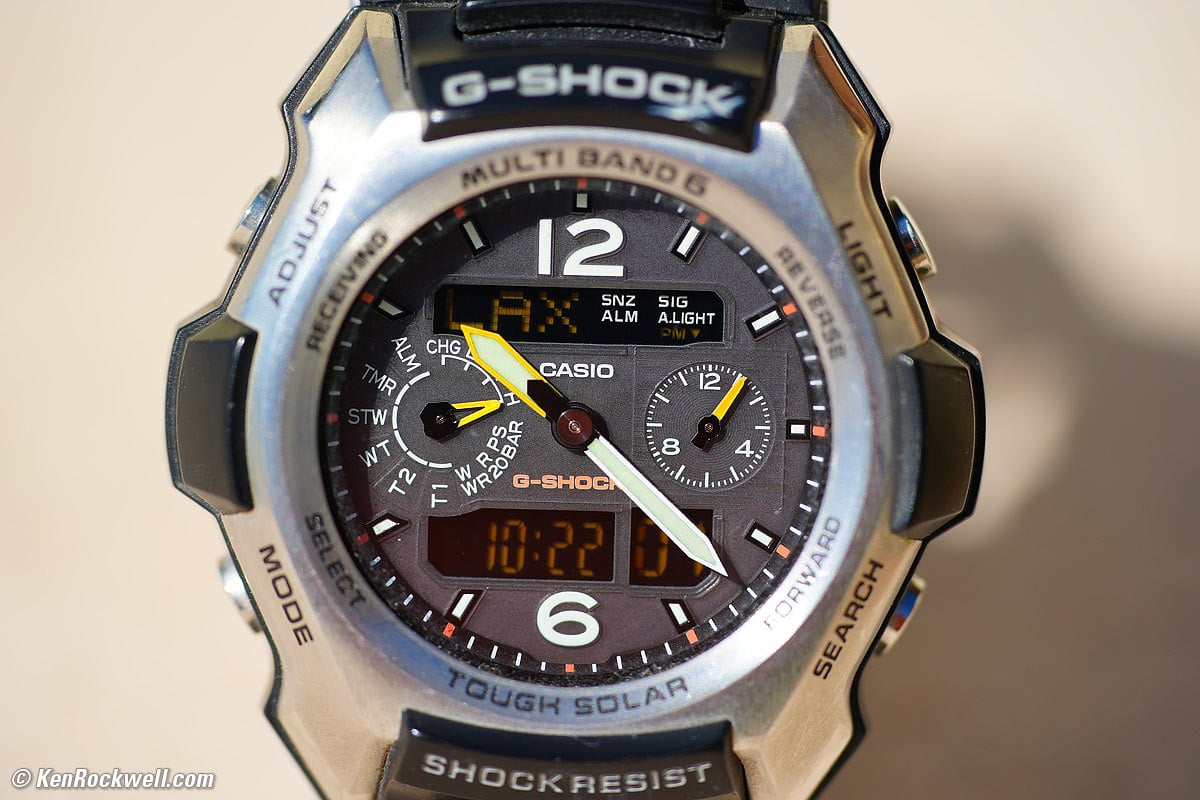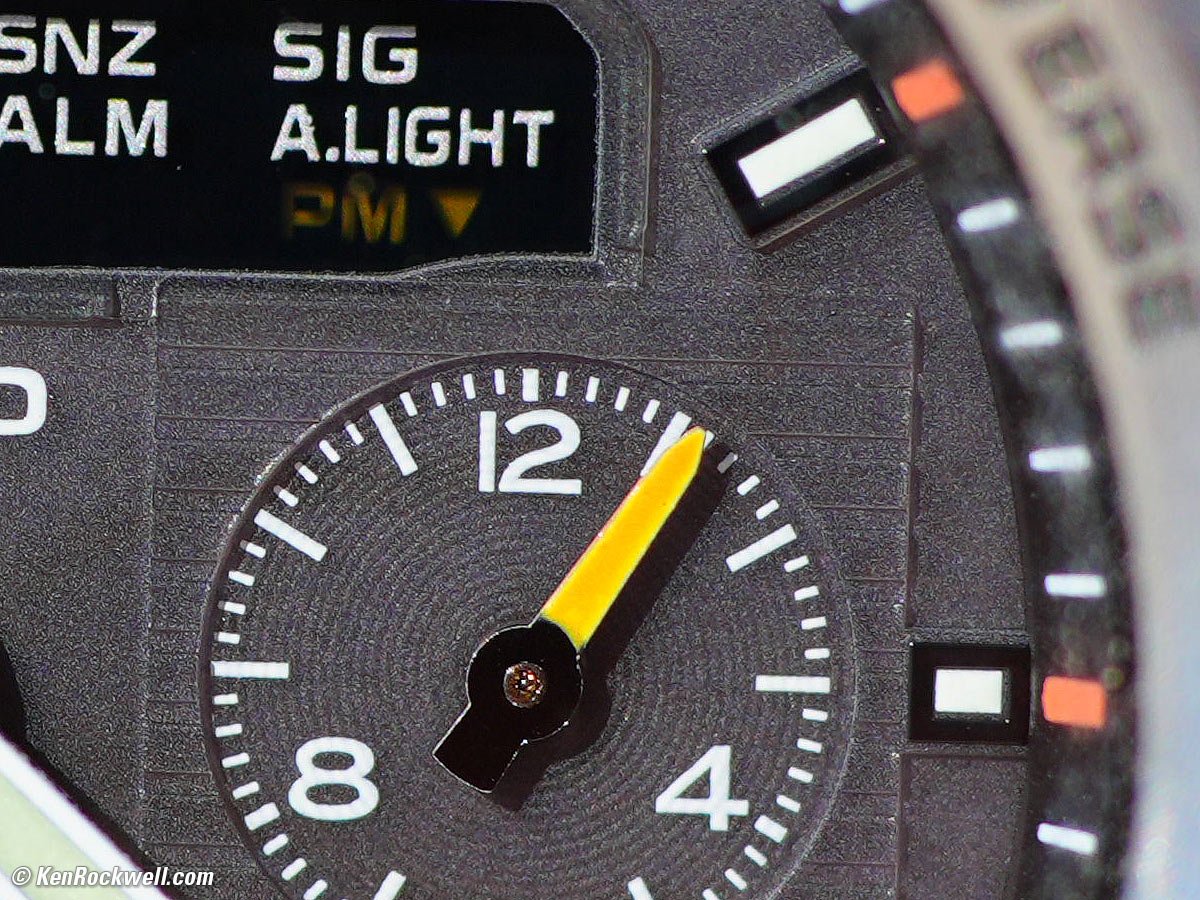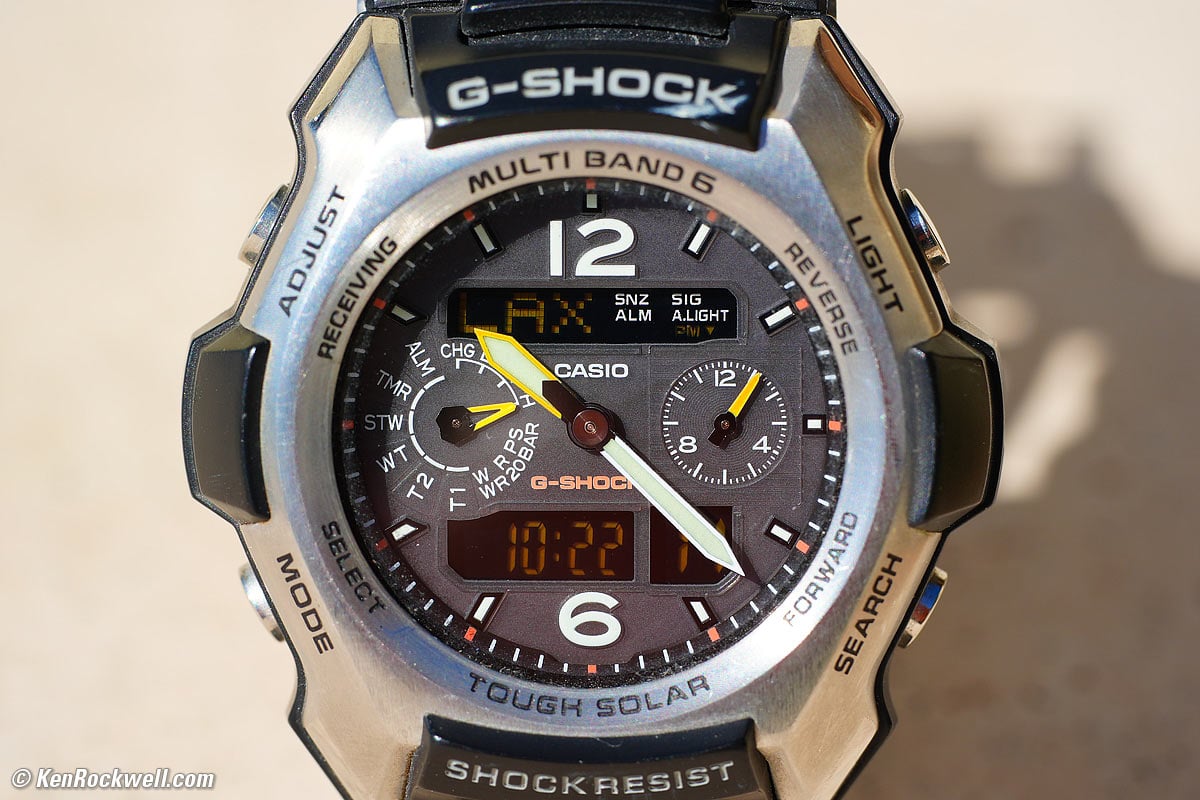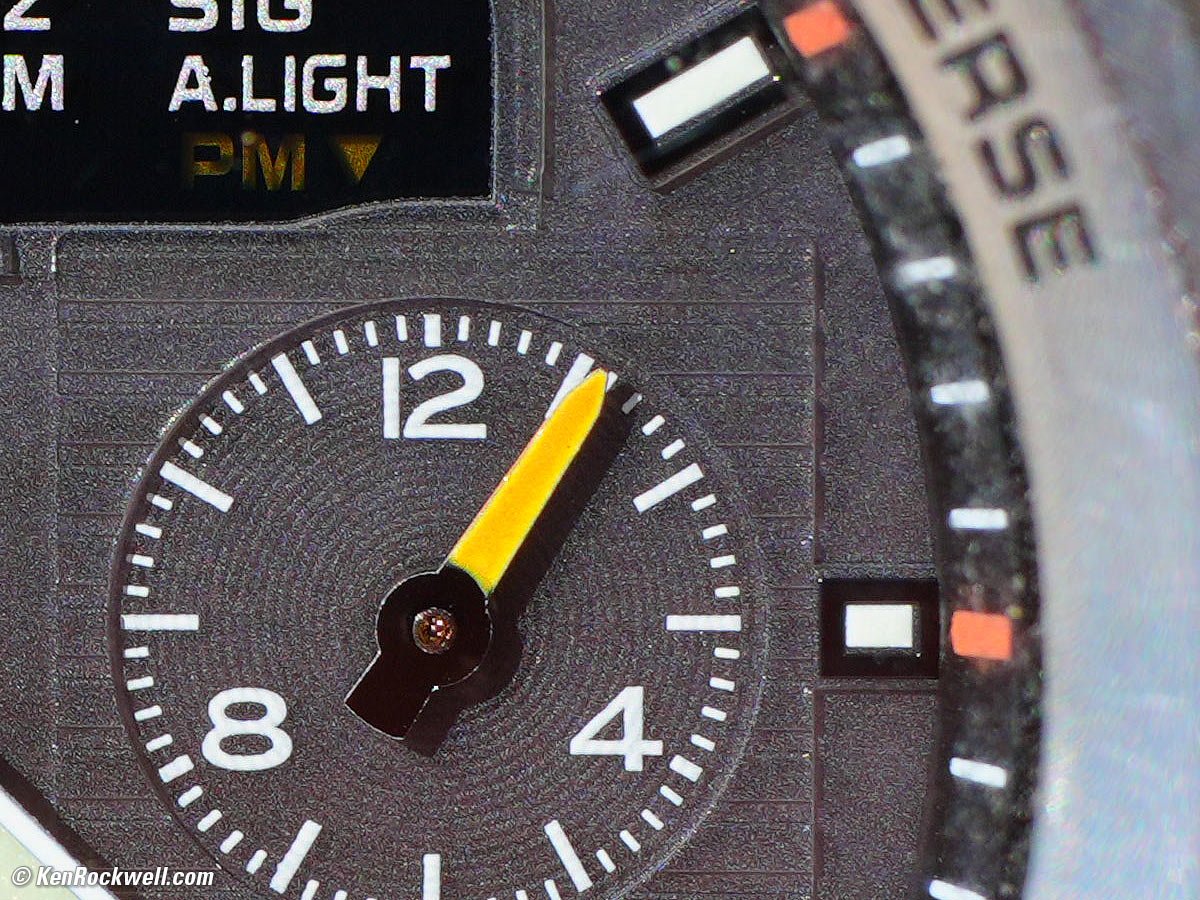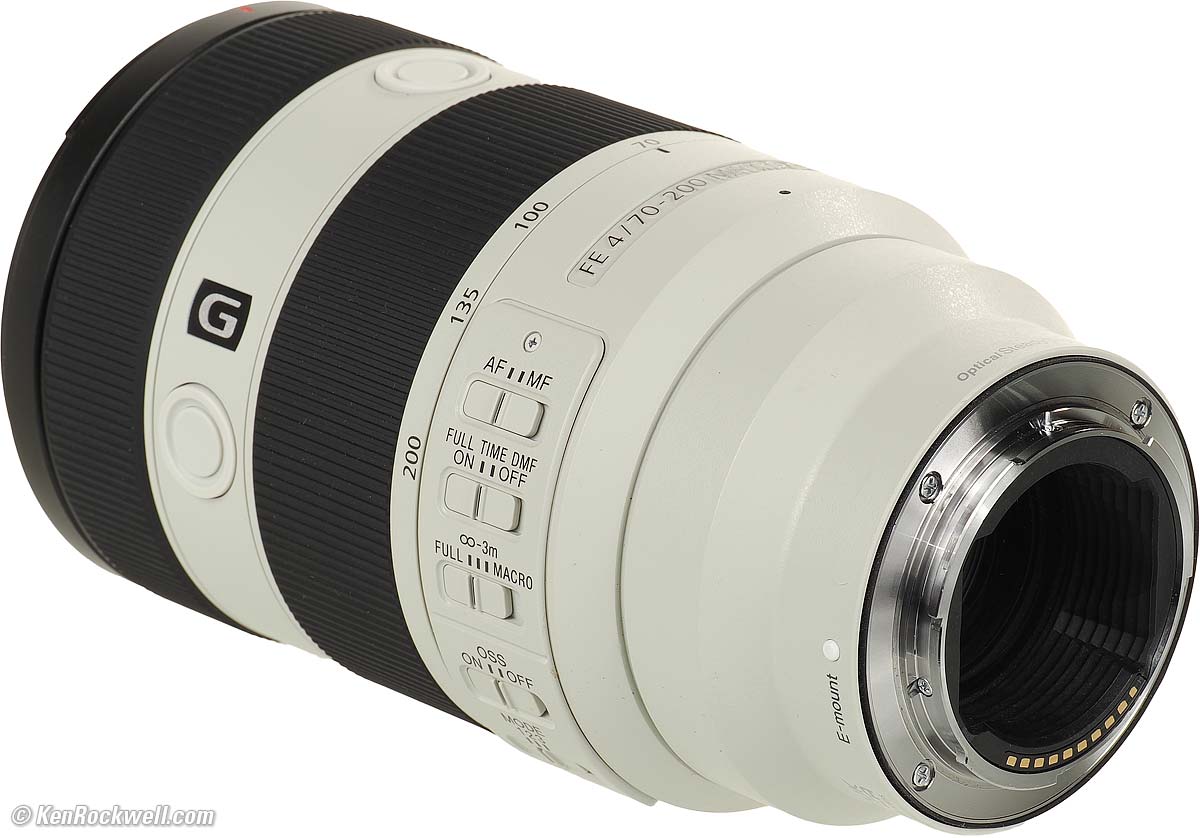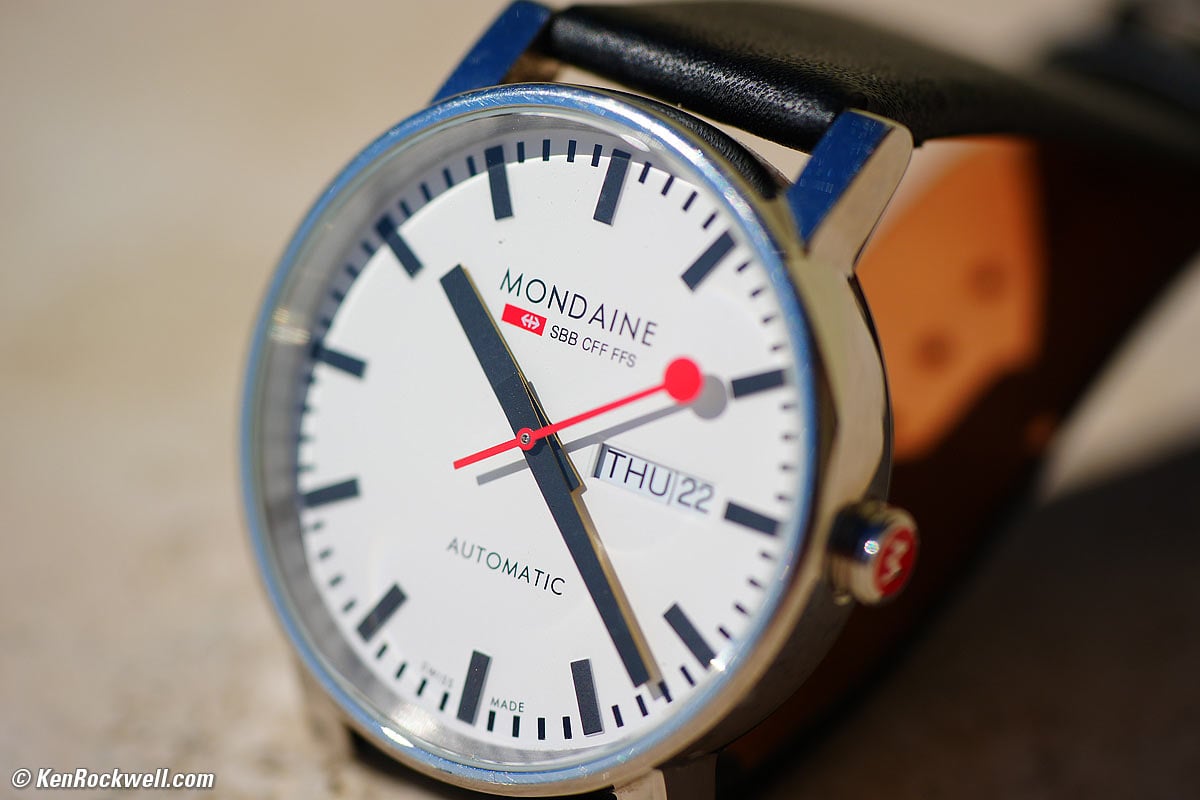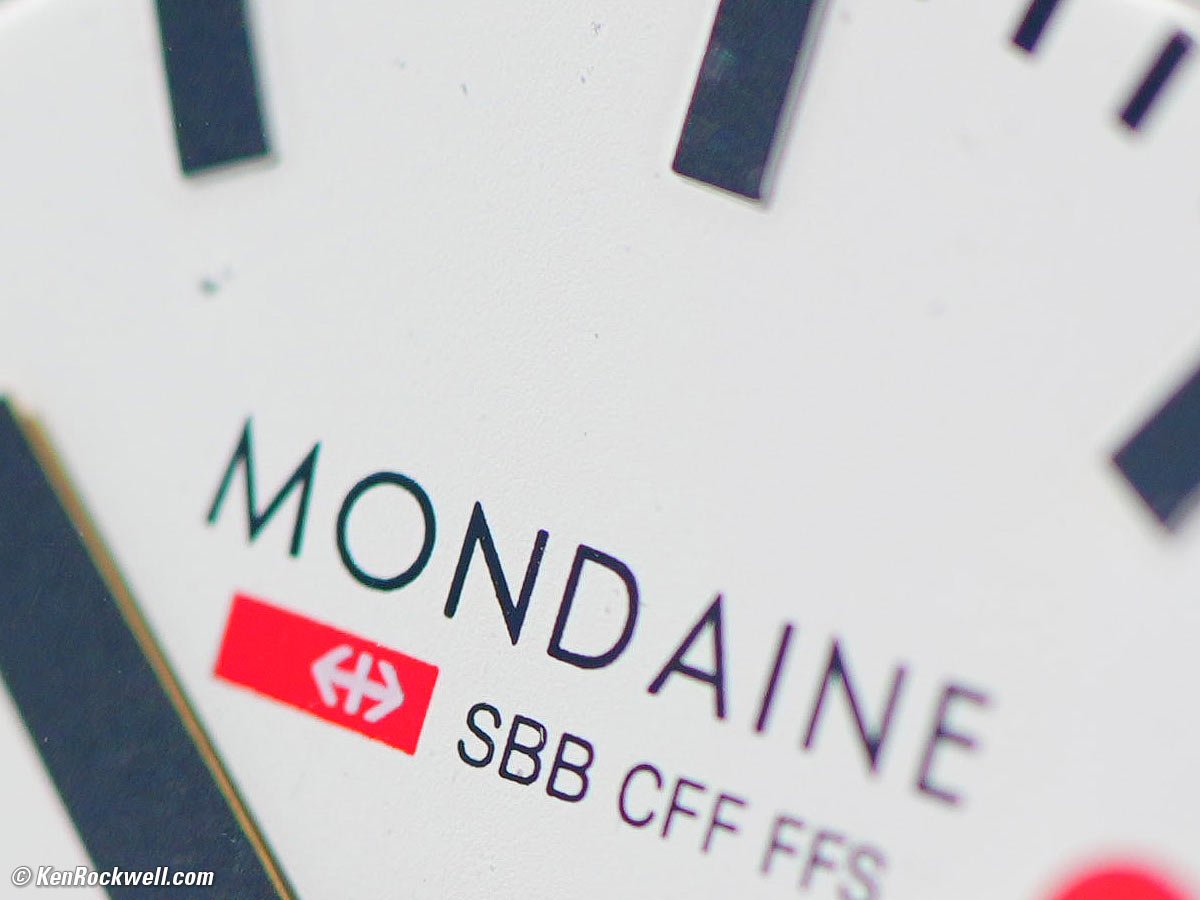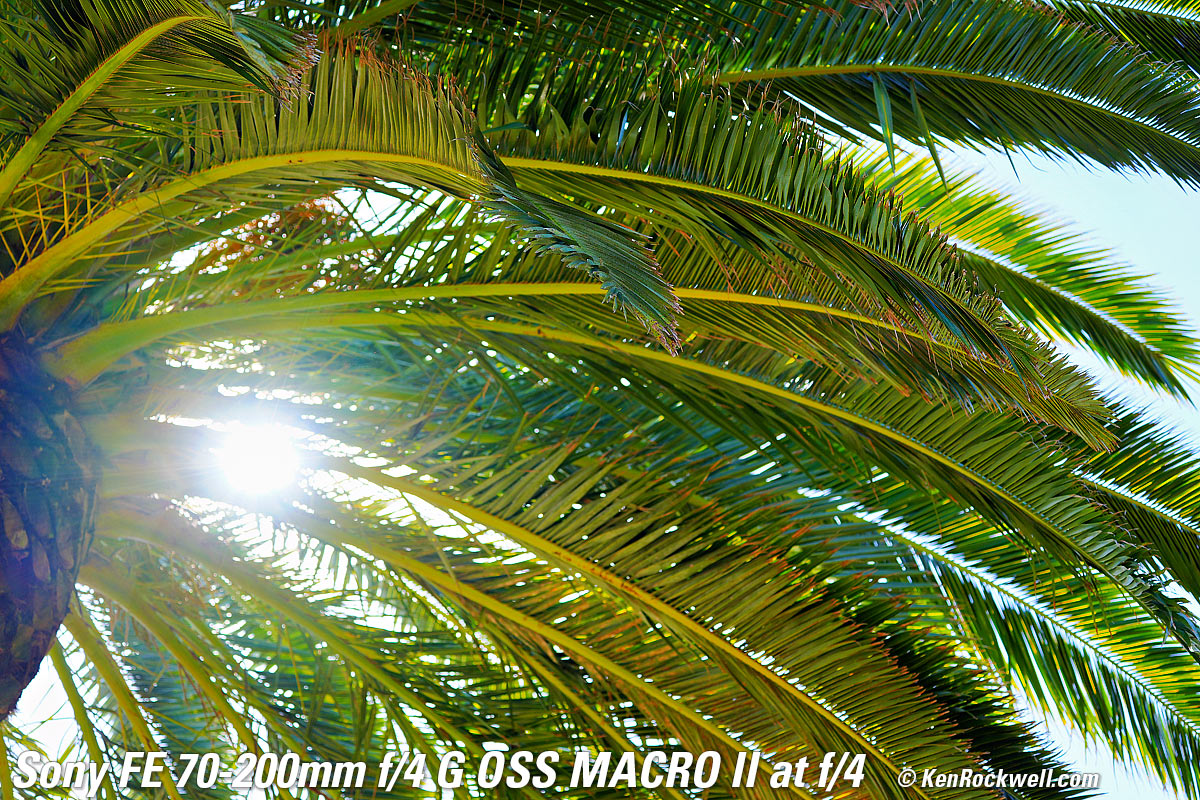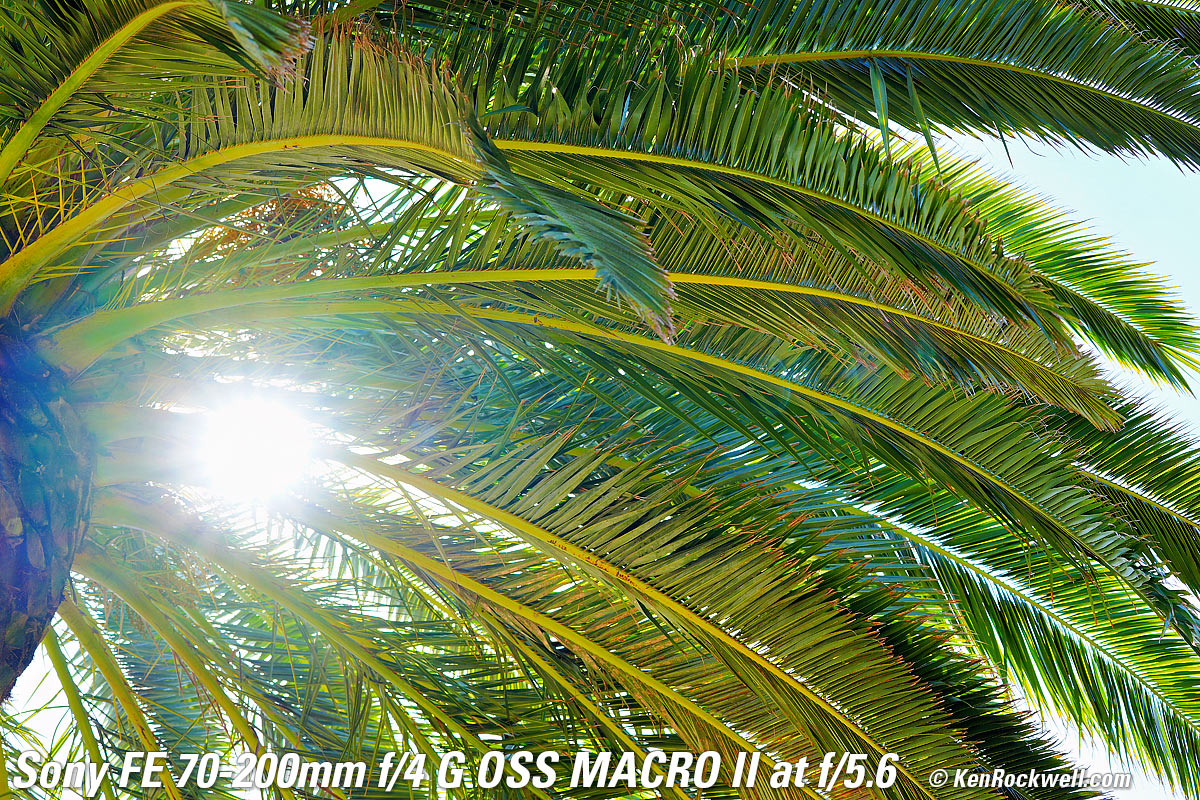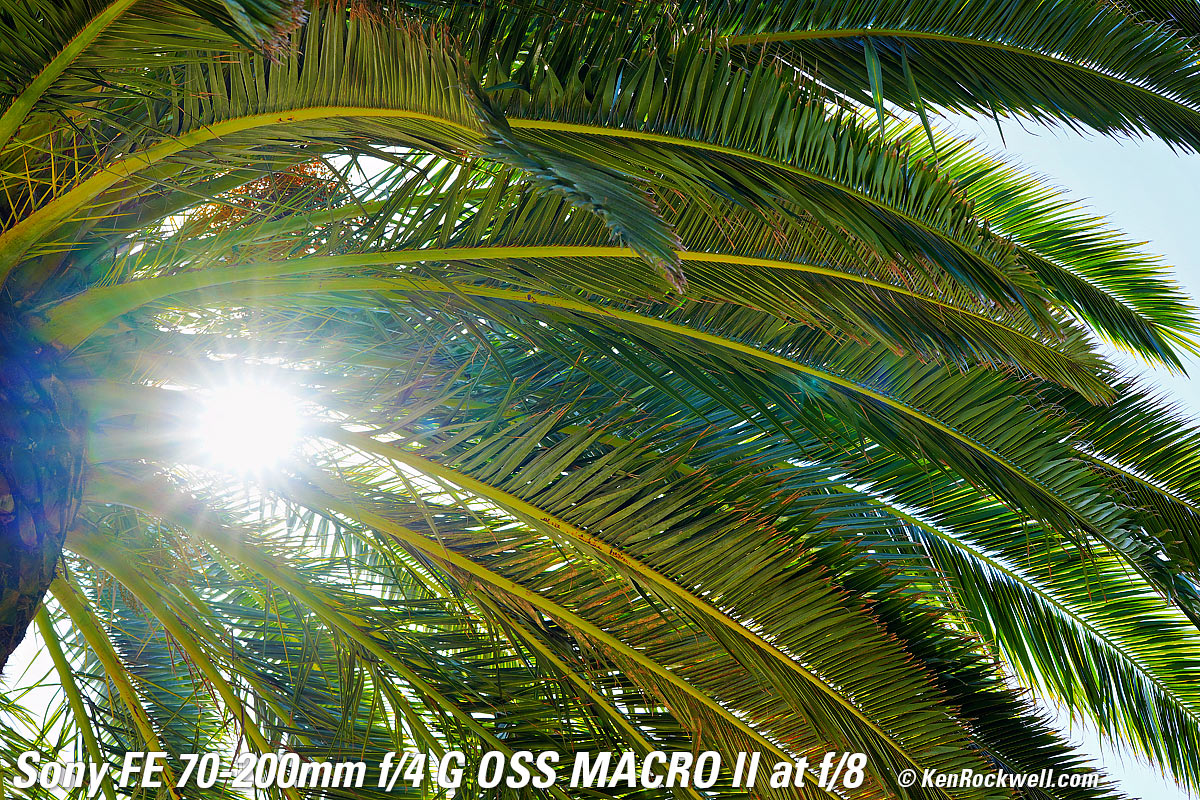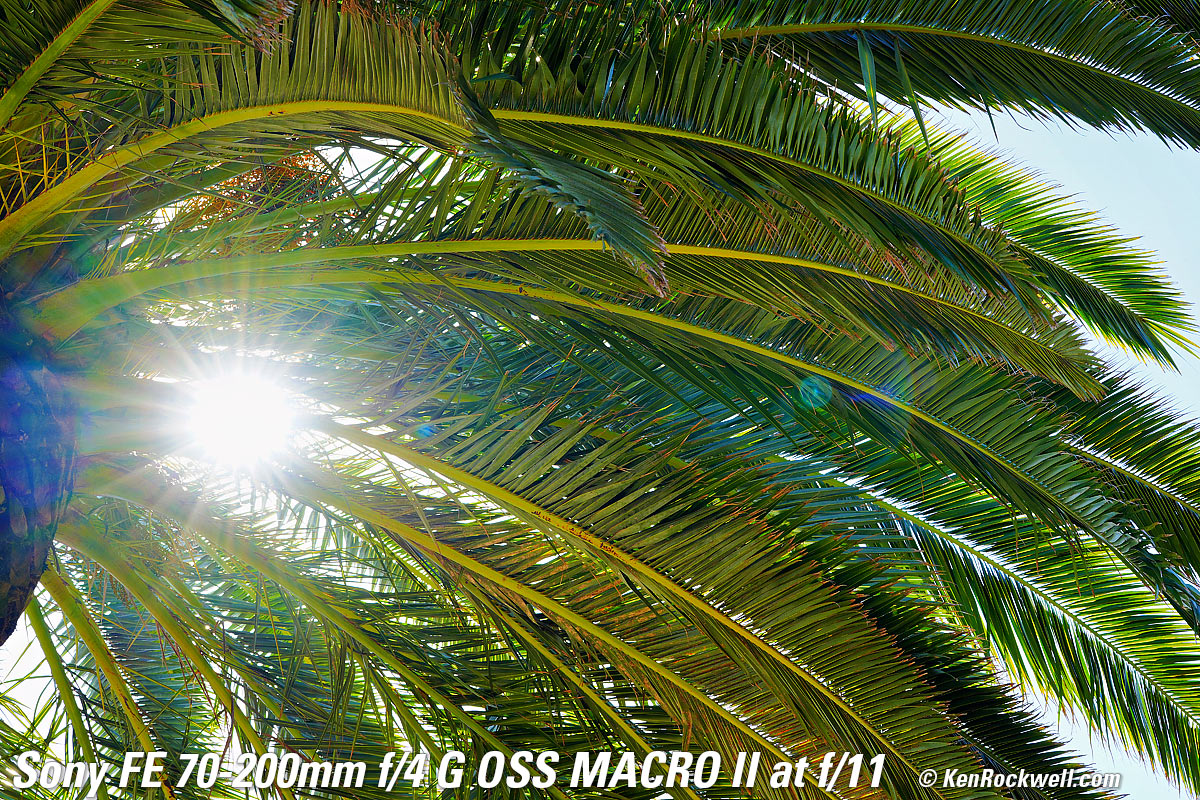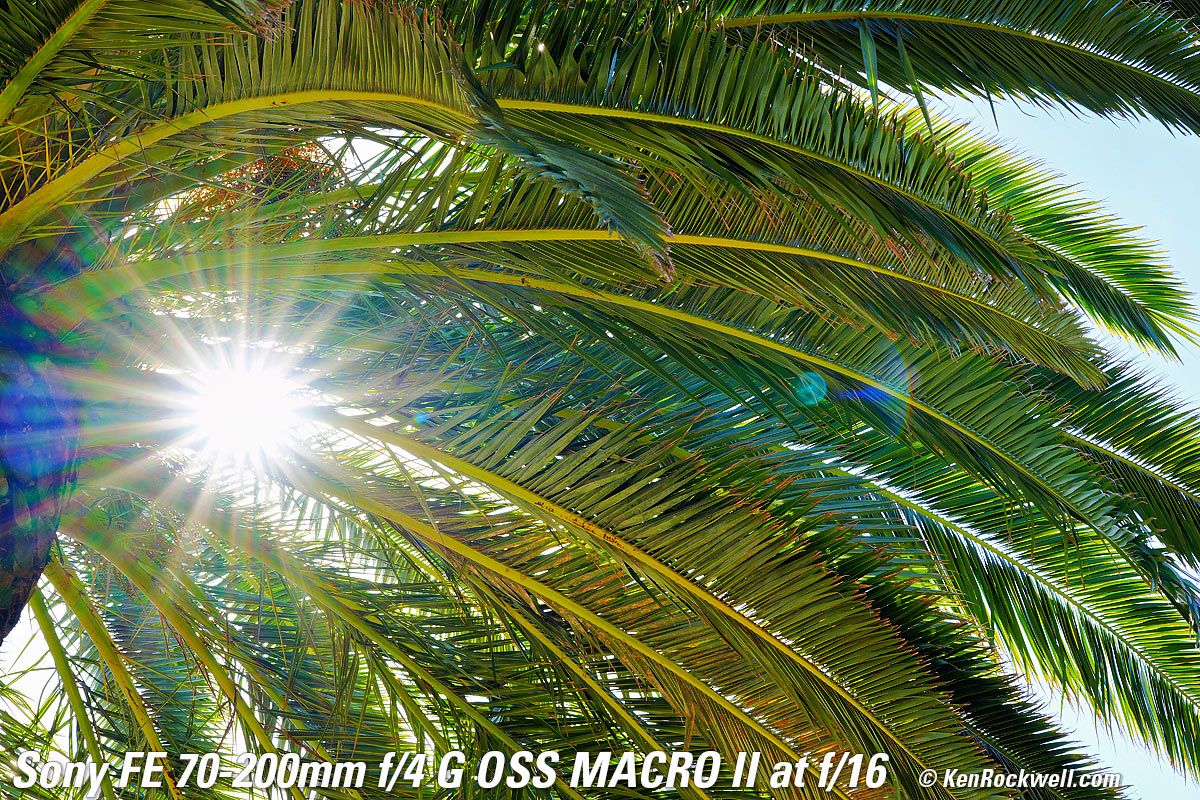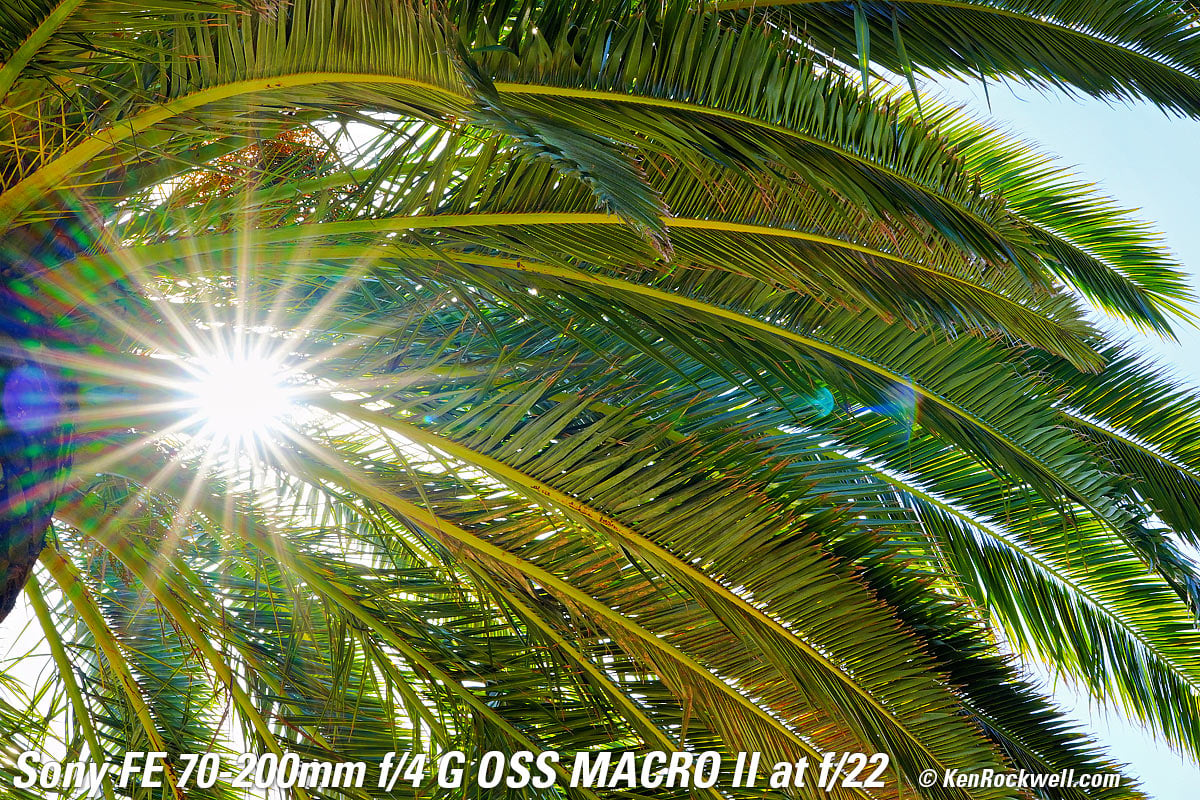Sony FE 70‑200mm f/4 Macro G OSS II
Compact Tele Zoom
Sample Images Intro New Good Bad Missing
Specifications Performance Compared
Sony: A9 III A1 A9 II A9 A7R V A7R IV A7R III A7 IV A7 III A7R II A7S III A7c A7 II A6600 A6400 A6100 A6000 ZV-E10 RX10/4 RX100/7 RX100/6 Flash Lenses
Sony FE 70-200mm f/4 Macro G OSS II (72mm filters, 27.9 oz./791g w/o collar, 30.3 oz./859g w/collar as shown, 0.85'/0.26m ~ 1.4'/0.42m close focus, 0.5× macro ratio, $1,698). bigger. I'd get mine at Adorama, at Amazon, at B&H (also comes as a kit with a free filter for the same price) or at Crutchfield, or get it used at eBay if you know How to Win at eBay.
This 100% all-content, junk-free website's biggest source of support is when you use those or any of these links to my personally approved sources I've used myself for way over 100 combined years when you get anything, regardless of the country in which you live — but I receive nothing for my efforts if you take the chance of getting it elsewhere. Sony does not seal its boxes in any way, so never buy at retail or any other source not on my personally approved list since you'll have no way of knowing if you're missing accessories, getting a defective, damaged, returned, dropped, incomplete, gray-market, store demo or used lens — and my personally approved sources allow for 100% cash-back returns for at least 30 days if you don't love your new lens. I've used many of these sources since the 1970s because I can try it in my own hands and return it if I don't love it, and because they ship from secure remote warehouses where no one gets to touch your new lens before you do. Buy only from the approved sources I've used myself for decades for the best prices, service, return policies and selection.
March 2024 Better Pictures Sony Sony Lenses Canon Nikon Fuji LEICA Zeiss All Reviews
Sony vs. Nikon vs. Canon Full-Frame
Canon, Nikon, Sony, Fuji & OM SYSTEM Menu Systems Compared.
Sample Images top
Sample Images Intro New Good Bad Missing
Specifications Performance Compared
More samples throughout this review at Bokeh, Falloff, Macro, Spherochromatism and Sunstars.
These are just snapshots; my real work is in my Gallery.
These are all shot hand-held as STANDARD JPGs; no tripods, no FINE or EXTRA FINE JPGs or RAW files were used or needed.
Desert Sunset, La Quinta, California, 5:38 PM, Friday, 23 February 2024. Sony A9 Mk III VIVID image with +9 Saturation, Sony FE 70-200mm f/4 G OSS Macro II at 79mm at f/5 at 1/125 at Auto ISO 250 (LV 10.3), Radiant Photo and Skylum Luminar Neo software. bigger or camera-original © file.
Introduction top
Sample Images Intro New Good Bad Missing
Specifications Performance Compared
|
I buy only from these approved sources. I can't vouch for ads below. |
This Sony FE 70‑200mm f/4 Macro G OSS II is a smaller, lighter and much closer-focussing version of Sony's previous FE 70-200mm f/4 G OSS.
It's sharp, small, light, usually replaces a separate macro lens and focuses remarkably quickly, even between macro and distant subjects. Bravo!
While I prefer either the 24-240mm or 100-400mm ranges, if you prefer 70-200mm lenses, this is a superb one as it also usually replaces having to carry a separate macro lens, and it's small and light.
Bravo!
It works with the FE 1.4× Teleconverter and FE 2× Teleconverter.
I'd get my FE 70‑200mm f/4 Macro G OSS II at Adorama, at Amazon, at B&H (also comes as a kit with a free filter for the same price) or at Crutchfield, or get it used at eBay if you know How to Win at eBay.
New intro top
 Smaller, lighter and much closer-focussing version of Sony's previous FE 70-200mm f/4 G OSS.
Smaller, lighter and much closer-focussing version of Sony's previous FE 70-200mm f/4 G OSS.
Good intro top
 Sharp.
Sharp.
 0.5× macro at all focal lengths, all in one continuous focus range.
0.5× macro at all focal lengths, all in one continuous focus range.
 Super fast autofocusing, even with huge changes in distance. Bravo!
Super fast autofocusing, even with huge changes in distance. Bravo!
 AF doesn't get stuck when an image is hugely out-of-focus as often happens with other macro lenses. Bravo!
AF doesn't get stuck when an image is hugely out-of-focus as often happens with other macro lenses. Bravo!
 Small.
Small.
 Light.
Light.
 3 programmable focus lock buttons
3 programmable focus lock buttons
 AF/MF switch.
AF/MF switch.
 Stabilizer switch.
Stabilizer switch.
 Hood included.
Hood included.
 Tripod collar included.
Tripod collar included.
 The tripod collar is removable and not really needed with such a light lens.
The tripod collar is removable and not really needed with such a light lens.
Bad intro top
 Production dumped to China, not made domestically in Japan.
Production dumped to China, not made domestically in Japan.
Sony FE 70-200mm f/4 Macro G OSS II. bigger.
 Soft plastic filter threads are easy to cross thread, typical of consumer lenses in 2024.
Soft plastic filter threads are easy to cross thread, typical of consumer lenses in 2024.
 Plastic exterior.
Plastic exterior.
Missing intro top
 No aperture ring.
No aperture ring.
 Tiny mounting index dot is the same white as everything else, so it doesn't stand out when you need to find it to mount your lens.
Tiny mounting index dot is the same white as everything else, so it doesn't stand out when you need to find it to mount your lens.
 No universal always-active manual-focus override, typical for Sony lenses.
No universal always-active manual-focus override, typical for Sony lenses.
 No case included.
No case included.
 No focus or depth-of-field scales.
No focus or depth-of-field scales.
 No infra-red focus indices.
No infra-red focus indices.
Sony FE 70-200mm f/4 Macro G OSS II. bigger.
Specifications top
Sample Images Intro New Good Bad Missing
Specifications Performance Compared
I'd get my FE 70‑200mm f/4 Macro G OSS II at Adorama, at Amazon, at B&H (also comes as a kit with a free filter for the same price) or at Crutchfield, or get it used at eBay if you know How to Win at eBay.
Name specifications top
Sony calls this the Sony FE 70-200mm F4 Macro G OSS II:
FE: Full-frame coverage, E-mount.
Macro: Focuses very closely.
G: "Good," meaning Sony's nearly best, but not quite as physically tough and good as Sony's GM "Good Master" lenses.
OSS: "Optical Steady Shot" Image Stabilization.
II: Sony's second version of this lens. The original was larger and didn't focus anywhere near as closely.
Sony's model number: SEL70200G2
Compatibility specifications top
This works on all Sony E-mount cameras, full-frame and crop-sensor. This includes all the variations of NEX, A1, A9-, A7-, A6xxx and A5xxx series cameras
It works with the FE 1.4× Teleconverter or FE 2× Teleconverter.
It will not work on any Sony A-mount DSLR or any Minolta MAXXUM 35mm SLR of any kind. Those use the old A mount which was actually the Minolta MAXXUM mount from 1987.
Optics specifications top
Internal Optical Construction. ED, Super ED, Aspherical and Advanced Aspherical elements.
19 elements in 13 groups.
3 ED extra-low dispersion elements, which help reduce secondary axial chromatic aberration.
1 Super ED element, which are even better than ED elements.
1 Aspherical element.
1 Extreme Aspherical element. Extreme Aspherical is Sony's secret manufacturing process that yields uncommonly super-accurate and smooth surfaces to 10 nanometers precision; it's not that these elements have crazy shapes.
Diaphragm specifications top
Sony FE 70-200mm f/4 Macro G OSS II. bigger.
9 rounded blades.
Electronically actuated.
Stops down to f/22.
Filters specifications top
Plastic 72mm filter thread.
Focal Length specifications top
70-200mm.
When used on an APS-C camera, it sees the same angles of view as a 105-300mm lens sees when used on a full-frame camera.
See also Crop Factor.
Angle of View specifications top
34º ~ 12½º diagonal on full frame.
23º ~ 8º diagonal on full frame.
Autofocus specifications top
No external movement as focussed, so no air or dust is sucked in.
Focus Scale specifications top
No.
Not on lens, but may be displayed in-camera.
Infinity Focus Stop specifications top
No.
You have to focus somehow to get precise focus at infinity, just like at every other distance.
Depth of Field Scale specifications top
No.
Not on lens, but may be displayed in-camera.
Infrared Focus Index specifications top
No.
Close Focus (distance from subject to image plane) specifications top
70mm: 0.85 feet (0.26 meters).
200mm: 1.4 feet (0.42 meters).
Maximum Reproduction Ratio specifications top
1:2.0 (0.50×) at all focal lengths.
Reproduction Ratio Scale specifications top
No.
Not on lens, but may be displayed in-camera.
Caps specifications top
ALC-F72S front and ALC-R1EM rear cap, included.
Hood specifications top
Sony ALC-SH176 hood for FE 70-200mm f/4 Macro G OSS II. bigger.
The ALC-SH176 hood is included.
Case specifications top
No case included.
Tripod Collar specifications top
The solid-alloy tripod collar is removable and included.
Size specifications top
3.24" ø maximum diameter × 5.87" extension from flange at 70mm. Gets longer at 200mm.
82.2 mm ø maximum diameter × 149.0 mm extension from flange at 70mm. Gets longer at 200mm.
Weight specifications top
Lens Alone
27.910 oz. (791.3 g) actual measured weight, no collar.
Rated 28.0 oz. (794 g) for the lens alone.
Lens & Collar
30.295 oz. (858.8 g) actual measured weight, lens and collar.
Collar Alone
2.380 oz. (67.5 g) actual measured weight, collar only.
Quality specifications top
Made in China.
Announced specifications top
12 July 2023, 10 AM NYC time.
Included specifications top
ALC-F72S front and ALC-R1EM rear cap.
Tripod collar.
Sony's Model Number specifications top
SEL70200G2.
Price, U. S. A. specifications top
March 2024
$1,698 at Adorama, at Amazon, at B&H and at Crutchfield.
About $1,150 used if you know How to Win at eBay.
Performance top
Sample Images Intro New Good Bad Missing
Specifications Performance Compared
Overall Autofocus Manual Focus Breathing
Bokeh Distortion Ergonomics Falloff Filters
Flare & Ghosts Lateral Color Fringes
Lens Corrections Macro Mechanics
Sunstars Teleconverters Tripod Collar
I'd get my FE 70‑200mm f/4 Macro G OSS II at Adorama, at Amazon, at B&H (also comes as a kit with a free filter for the same price) or at Crutchfield, or get it used at eBay if you know How to Win at eBay.
Overall performance top
This is a wonderfully useful 70-200mm lens, especially when you consider that it doubles as a macro lens.
Autofocus performance top
Autofocus is immediate, even pulling all the way between macro and infinity. It just goes, about as fast or faster than my own eyes focus.
Better, AF doesn't get stuck if the image is very far out of focus as often happens with other macro lenses.
Manual Focus performance top
Manual focusing is entirely electronic; the manual focus ring isn't connected to anything other than a digital encoder.
Typical for Sony lenses, except for the clunky DMF mode, there is no always active instant manual focus override.
Focus Breathing performance top
Focus breathing is the image changing size as focused in and out. It's important to cinematographers that the image not breathe because it looks funny if the image changes size as focus gets pulled back and forth between actors. If the lens does this, the image "breathes" by growing and contracting slightly as the dialog goes back and forth.
The image from this lens becomes smaller as focused more closely at 70mm.
This effect becomes less as zoomed longer.
There is no breathing at 200mm.
Bokeh performance top
Bokeh, the feel, character or quality of out-of-focus areas as opposed to how far out of focus they are, is excellent, which I attribute to Sony using what they call an Advanced Aspherical element whose genuinely more precise manufacturing eliminates the "onion ring" effects of other aspherical technologies.
Here are photos from headshot distance wide-open. I'm focused on the DAVIS logo. Click either for its © camera-original file:
Made-in-U. S. A. Davis 6357 Wireless Sensor Suite (used with 6351 Vantage Vue console), 01 March 2024. Sony A9 Mk III VIVID image with +9 Saturation, Sony FE 70-200mm f/4 Macro OSS G II at 70mm f/4 at 1/3,200 at Auto ISO 250, +0.7 stops exposure compensation (LV 14.3), Radiant Photo software. bigger or camera-original © file.
Made-in-U. S. A. Davis 6357 Wireless Sensor Suite (used with 6351 Vantage Vue console), 01 March 2024. Sony A9 Mk III VIVID image with +9 Saturation, Sony FE 70-200mm f/4 Macro OSS G II at 200mm f/4 at 1/2,500 at Auto ISO 250, +0.7 stops exposure compensation (LV 14.0), Radiant Photo software. bigger or camera-original © file.
As always, if you want to throw the background as far out of focus as possible, shoot at 200mm at f/4 and get as close as possible.
Distortion performance top
The Sony FE 70-200mm f/4 Macro OSS G II has no visible distortion, which makes sense as Sony cameras always apply distortion correction with this lens— you can't turn off distortion correction.
If you shoot raw data rather than JPG images, whatever software you use to create visible images from raw data may or may not correct the distortion as is done in-camera as JPGs. You're on your own there; I don't bother with raw data.
For more critical scientific use, use these corrections in Photoshop's lens correction filter to JPG images. No, I have no idea why my A9 III doesn't correct the distortion completely.
These aren't facts or specifications, they are the results of my research that requires hours of photography and calculations on the resulting data.
On Full-Frame at 30' (10m) |
Correction factor with in-camera corrected images |
70mm |
+0.40 |
100mm |
+0.30 |
135mm |
+0.30 |
200mm |
±0.00 |
© 2024 KenRockwell.com. All rights reserved.
Ergonomics performance top
This is a handy little lightweight, mostly plastic lens:
Sony FE 70-200mm f/4 Macro G OSS II. bigger. |
Sony FE 70-200mm f/4 Macro G OSS II. bigger. |
Sony FE 70-200mm f/4 Macro G OSS II. bigger. |
Sony FE 70-200mm f/4 Macro G OSS II. bigger. |
The filter threads are crappy plastic, so be careful not to cross-thread anything.
The focus ring is purely electronic and mostly ignored unless you move the AF-MF switch to MF.
There's no always-responsive instant manual-focus override unless you try the rather limited DMF focus mode.
Sony FE 70-200mm f/4 Macro G OSS II. bigger.
The AF/MF switch is near the top on the left, which is perfect for moving it with my thumb. The other controls slate-in below it, which is as good as anyone can ask.
It's difficult to select OSS MODE 2, as it's too close between MODE 1 and MODE 3 so you have to be very careful to get to the middle MODE 2 setting.
The zoom ring is great; it's a real mechanical direct zoom control.
Falloff performance top
Falloff is invisible, at least with automated corrections left at their default of ON.
I've greatly exaggerated the falloff by shooting a gray field and placing these on a gray background; it will not look this bad in actual photos of real things:
Falloff on full-frame at infinity, correction at its default of ON:
© 2024 KenRockwell.com. All rights reserved. |
If you shoot raw data rather than JPG images, whatever software you use to create visible images from raw data may or may not correct this as is done in-camera as JPGs. You're on your own there; I don't bother with raw data.
If you go out of your way to turn off the correction, this is what you get:
Falloff on full-frame at infinity, correction turned OFF:
© 2024 KenRockwell.com. All rights reserved. |
Filters, use with performance top
There's no need for thin filters. I can mount quite a stack of standard 72mm filters with no vignetting at any setting on full-frame.
Go ahead and use your standard rotating polarizer and grad filters.
Flare & Ghosts performance top
No problem here!
See examples at Sunstars.
Lateral Color Fringes performance top
There are no color fringes as shot with the default automatic correction ON.
If you shoot raw data rather than JPG images, whatever software you use to create visible images from raw data may or may not correct this as is done in-camera as JPGs. You're on your own there; I don't bother with raw data.
There is spherochromatism, which can cause color fringes on things that aren't in perfect focus at large apertures. Spherochromatism is a completely different aberration in a different dimension than lateral color fringes.
Lens Corrections performance top
If you shoot raw data rather than JPG images, whatever software you use to create visible images from raw data may or may not correct these as is done in-camera as JPGs. You're on your own there; I don't bother with raw data.
My Sony A9 III corrects for any or all of Falloff ("Shading Comp."), Lateral Color ("Chromatic Aberration Comp.") and Distortion.
By default these are all ON.
Falloff ("Shading Comp.") and Lateral Color ("Chromatic Aberration Comp.") may be turned OFF if you like.
Distortion correction is always ON; it's part of the lens design to correct it electronically rather than optically. This gives the designers more freedom to make the lens smaller, sharper, less expensive and have this huge zoom range, something we could never do with film.
Macro Performance performance top
It gets super close and is also super sharp, even wide-open. Of course with any lens at distances this close there is never any depth-of-field, so very little if anything is ever in perfect focus, but that's physics and not a problem with this lens.
Wide-open at f/4
Casio G-Shock Solar Atomic Watch at close-focus distance, 22 February 2024. Sony A9 Mk III VIVID image with +9 Saturation, Sony FE 70-200mm f/4 Macro OSS G II at 200mm f/4 at 1/1,600 at Auto ISO 250 (LV 13.3). bigger or camera-original © file. bigger or camera-original © file.
1,200 × 900 pixel (5× magnification) crop from above. bigger or camera-original © file.
If this 1,200 × 900 pixel crop is about 3" (7.5cm) wide on your screen, then the complete image printed at this same large magnification would be about 10 × 15" (25 × 38cm).
If this 1,200 × 900 pixel crop is about 6" (15cm) wide on your screen, then the complete image printed at this same extreme magnification would be about 20 × 30" (50 × 75cm).
If this 1,200 × 900 pixel crop is about 12" (30cm) wide on your screen, then the complete image printed at this same insanely high magnification would be about 40 × 60" (1 × 1.5 meters).
At f/8
Of course it gets even sharper, mostly because there is more in focus, at f/8:
Casio G-Shock Solar Atomic Watch at close-focus distance, 22 February 2024. Sony A9 Mk III VIVID image with +9 Saturation, Sony FE 70-200mm f/4 Macro OSS G II at 200mm f/4 at 1/1,600 at Auto ISO 250 (LV 13.3). bigger or camera-original © file. bigger or camera-original © file.
1,200 × 900 pixel (5× magnification) crop from above. bigger or camera-original © file.
If this 1,200 × 900 pixel crop is about 3" (7.5cm) wide on your screen, then the complete image printed at this same large magnification would be about 10 × 15" (25 × 38cm).
If this 1,200 × 900 pixel crop is about 6" (15cm) wide on your screen, then the complete image printed at this same extreme magnification would be about 20 × 30" (50 × 75cm).
If this 1,200 × 900 pixel crop is about 12" (30cm) wide on your screen, then the complete image printed at this same insanely high magnification would be about 40 × 60" (1 × 1.5 meters).
Mechanical Quality performance top
Sony FE 70-200mm f/4 Macro G OSS II. bigger.
This is a lightweight, mostly plastic lens with a metal mount and all-metal tripod collar.
Finish
Off-white paint.
Hood
Off-white painted plastic bayonet.
Front Bumper
None.
Filter Threads
Soft plastic, easy to cross thread.
Hood Bayonet Mount
Plastic.
Front Vanity Trim Ring (just behind hood mount, with red index dot)
Metal.
Front Barrel Exterior
Plastic.
Focus Ring
Rubber-covered plastic.
Mid Barrel Exterior
Section with focus lock buttons: plastic.
Zoom Ring
Rubber-covered plastic.
Slide Switches
All plastic.
Rear Barrels
Plastic.
Identity
Printed on front trim ring just behind hood mount, also a metallic-look plate on top of barrel.
Internals
Seem like mostly or entirely plastic.
Dust Gasket at Mount
Yes.
Mount
Metal.
Markings
All paint.
Tripod Collar
All solid alloy.
Serial Number
Sony FE 70-200mm f/4 Macro G OSS II. bigger.
Laser engraved on bottom of barrel.
Date Code
None found.
Noises When Shaken
Strong clunking, presumably from the focus groups flopping around with the power off.
Much quieter on the camera with the power ON, which locks-down the focus system.
Made in
Made in China.
Sharpness performance top
Lens sharpness has nothing to do with picture sharpness; every lens made in the past 100 years is more than sharp enough to make super-sharp pictures if you know what you're doing. The only limitation to picture sharpness is your skill as a photographer. It's the least talented who spend the most time worrying about lens sharpness and blame crummy pictures on their equipment rather than themselves. Skilled photographers make great images with whatever camera is in their hands; I've made some of my best images of all time with an irreparably broken camera! Most pixels are thrown away before you see them, but camera makers don't want you to know that.
If you're not getting ultra-sharp pictures with this, be sure not to shoot at f/11 or smaller where all lenses are softer due to diffraction, always shoot at ISO 100 or below because cameras become softer at ISO 200 and above, avoid shooting across long distances over land which can lead to atmospheric heat shimmer, be sure everything is in perfect focus, set your camera's sharpening as you want it (I set mine to the maximum) and be sure nothing is moving, either camera or subject. If you want to ensure a soft image with any lens, shoot at f/16 or smaller at ISO 1,600 or above at default sharpening in daylight of subjects at differing distances in the same image.
People worry waaaaay too much about lens sharpness. It's not 1968 anymore when lenses often weren't that sharp and there could be significant differences among them; ever since about 2010 all new lenses are all pretty much equally fantastic.
This lens is super sharp corner-to corner at every aperture, limited of course by diffraction at the smallest apertures. Avoid f/16 and smaller unless you really need it for depth of field because diffraction takes its toll.
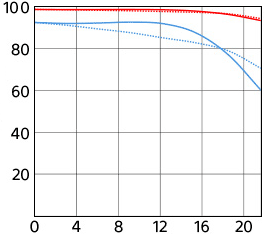 |
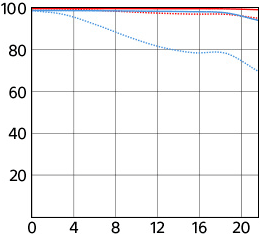 |
MTF at 70mm at f/4. |
MTF at 70mm at f/8. |
10 cyc/mm and 30 cyc/mm, radial (solid) and tangential (dotted).
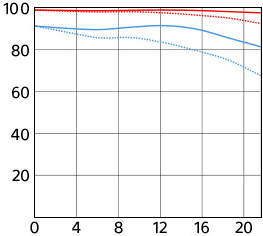 |
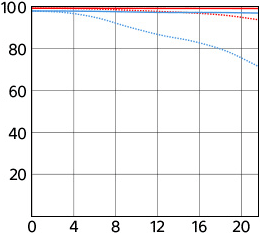 |
MTF at 200mm at f/4. |
MTF at 200mm at f/8. |
10 cyc/mm and 30 cyc/mm, radial (solid) and tangential (dotted).
Spherochromatism performance top
Spherochromatism, also called secondary spherical chromatic aberration or "color bokeh," is an advanced form of spherical and chromatic aberration in a different dimension than lateral chromatic aberration. It happens mostly in fast normal and tele lenses when spherical aberration at the ends of the color spectrum are corrected differently than in the middle of the spectrum. Spherochromatism can cause colored fringes on out-of-focus highlights, usually seen as green fringes on backgrounds and magenta fringes on foregrounds. Spherochromatism is common in fast lenses of moderate focal length when shooting contrasty items at full aperture. It goes away as stopped down.
It has some minor spherochromatism:
Mondaine A132.30348.11SBB at close-focus distance, 22 February 2024. Sony A9 Mk III VIVID image with +9 Saturation, Sony FE 70-200mm f/4 Macro OSS G II at 200mm f/4 at 1/4,000 at Auto ISO 250 (LV 14.6). bigger or camera-original © file.
1,200 × 900 pixel (5× magnification) crop from above. bigger or camera-original © file.
If this 1,200 × 900 pixel crop is about 3" (7.5cm) wide on your screen, then the complete image printed at this same large magnification would be about 10 × 15" (25 × 38cm).
If this 1,200 × 900 pixel crop is about 6" (15cm) wide on your screen, then the complete image printed at this same high magnification would be about 20 × 30" (50 × 75cm).
If this 1,200 × 900 pixel crop is about 12" (30cm) wide on your screen, then the complete image printed at this same extreme magnification would be about 40 × 60" (1 × 1.5 meters).
Sunstars performance top
With a 9-bladed rounded diaphragm, I get mild 18-point sunstars on brilliant points of light mostly at the smaller apertures.
Likewise ignore the crazy rainbow dots at small apertures; these are sensor artifacts caused by taking a picture directly of the sun and exposing for the dark underside of a huge palm tree, and using that same palm tree to hide the sky to accentuate the stars.
Click any to enlarge:
Click any to enlarge.
Teleconverters performance top
It works with the FE 1.4× Teleconverter or FE 2× Teleconverter.
I haven't tried it; but with other mirrorless combinations teleconverters work very well, far, far better than they ever did with DSLRs.
Tripod Collar performance top
The solid aluminum alloy tripod collar is removable and included.
It's a good copy of the excellent Canon collars, with a locking thumbscrew that can adjust the tension (to control friction) and pulls-out to pop-open the collar to remove the lens.
There are no 90º clicks.
The collar's foot has a standard ¼″ × 20 tripod thread and a hole presumable to receive a spring-loaded alignment pin.
Oddly the ¼″ × 20 tripod threads seem simply to be cut into the aluminum alloy and not as brass or steel bushings as seen in Canon and Nikon's feet. At first I was concerned until I realized that this lens weighs so little that it doesn't even need a collar, so no harm here.
Compared top
Sample Images Intro New Good Bad Missing
Specifications Performance Compared
I'd get my FE 70‑200mm f/4 Macro G OSS II at Adorama, at Amazon, at B&H (also comes as a kit with a free filter for the same price) or at Crutchfield, or get it used at eBay if you know How to Win at eBay.
While I personally prefer other zoom ranges like FE 24-240mm or FE 100-400mm, if 70-200mm is your thing, this lens is awesome for its unmatched macro ability, even better than Nikon's unique AF-D 70-180mm Micro-NIKKOR.
This lens also has faster autofocus than most, if not all, other similar lenses.
I'm not impressed by f/2.8 zooms. They were needed back in the olden days of film where we often needed f/2.8 because good film was ISO 50 or 100 and ISO 400 film was ratty, while today with digital's superb high ISOs I see no need for f/2.8 lenses.
User's Guide top
Sample Images Intro New Good Bad Missing
Specifications Performance Compared
I'd get my FE 70‑200mm f/4 Macro G OSS II at Adorama, at Amazon, at B&H (also comes as a kit with a free filter for the same price) or at Crutchfield, or get it used at eBay if you know How to Win at eBay.
Sony FE 70-200mm f/4 Macro G OSS II. bigger.
AF - MF Switch user's guide top
AF: Auto Focus.
MF: Manual Focus only.
Full Time DMF user's guide top
This is a failed attempt at full-time manual focus override. Nikon does this much better in every one of their lenses.
While it does give full-time manual focus focus override in AF-S, it doesn't work properly in AF-C. In AF-C you'll think it's working because focus changes when you turn the ring, but as soon as you stop turning it the AF system takes over immediately and keeps changing the focus on you!
Full / ∞-3m / MACRO Switch user's guide top
This is a focus limiter. Leave it in FULL.
This lens has such great autofocus it doesn't need this switch, which in olden days was needed to keep AF systems from becoming confused and trying to focus in the wrong ranges.
The ∞-3m position prevents the lens from autofocusing closer than 3 meters (10 feet). Use this setting only if you're having a problem with the lens attempting to focus on irrelevant close items, or if for some reason the lens is "hunting" from near to far looking for distant subjects.
The MACRO setting prevents autofocus from focusing further then 1 meter (3 feet).
If for some reason your lens refuses to autofocus, check to see that this switch hasn't been knocked to a position other then FULL.
OSS (Stabilizer) Switches user's guide top
ON / OFF
Leave it ON unless you're on a very sturdy tripod, or if you're making exposures longer than a second on any kind of tripod.
Mode 1 / 2 / 3
Mode 1: Normal.
Mode 2: Panning.
Mode 3: For sports: makes it easier to frame and shoot and saves power by only working when you take the picture.
Recommendations top
Sample Images Intro New Good Bad Missing
Specifications Performance Compared
I'd get my FE 70‑200mm f/4 Macro G OSS II at Adorama, at Amazon, at B&H (also comes as a kit with a free filter for the same price) or at Crutchfield, or get it used at eBay if you know How to Win at eBay.
Want a 70-200mm for your Sony? For most people this is the best choice.
I use a clear (UV) protective filter instead of a cap (exactly like an iPhone) so I'm always ready to shoot instantly. I only use a cap when I throw this in a bag with other gear without padding — which is never. The UV filter never gets in the way, and never gets lost, either.
The very best protective filter is the 72mm Hoya multicoated HD3 UV which uses hardened glass and repels dirt and fingerprints.
For less money, the Canon 72mm PROTECT, B+W 72mm 010 MRC MASTER, Hoya 72mm NXT Plus and even the most basic Hoya 72mm multicoated UV all work great to protect this lens with varying degrees of environmental toughness, while the Hoya HD3 is the toughest and longest-lasting in the field.
Filters last a lifetime, so you may as well get the best. The Hoya HD3 stays cleaner than the others since it repels oil and dirt.
All these filters are just as sharp and take the same pictures, the difference is how much abuse they'll take and stay clean and stay in one piece. Since filters last a lifetime or more, there's no reason not to buy the best as it will last you for the next 40 years. Filters aren't throwaways like digital cameras which we replace every few years, like it or not. I'm still using filters I bought back in the 1970s!
I'd get my FE 70‑200mm f/4 Macro G OSS II at Adorama, at Amazon, at B&H (also comes as a kit with a free filter for the same price) or at Crutchfield, or get it used at eBay if you know How to Win at eBay.
This 100% all-content, junk-free website's biggest source of support is when you use those or any of these links to my personally approved sources I've used myself for way over 100 combined years when you get anything, regardless of the country in which you live — but I receive nothing for my efforts if you take the chance of getting it elsewhere. Sony does not seal its boxes in any way, so never buy at retail or any other source not on my personally approved list since you'll have no way of knowing if you're missing accessories, getting a defective, damaged, returned, dropped, incomplete, gray-market, store demo or used lens — and my personally approved sources allow for 100% cash-back returns for at least 30 days if you don't love your new lens. I've used many of these sources since the 1970s because I can try it in my own hands and return it if I don't love it, and because they ship from secure remote warehouses where no one gets to touch your new lens before you do. Buy only from the approved sources I've used myself for decades for the best prices, service, return policies and selection.
Thanks for helping me help you!
Ken.
© Ken Rockwell. All rights reserved. Tous droits réservés. Alle vorbehalten. Alla rättigheter förbehållna. Toate drepturile rezervate. Ken Rockwell® is a registered trademark.
Help Me Help You top
I support my growing family through this website, as crazy as it might seem.
The biggest help is when you use any of these links when you get anything. It costs you nothing, and is this site's, and thus my family's, biggest source of support. These places always have the best prices and service, which is why I've used them since before this website existed. I recommend them all personally.
If you find this page as helpful as a book you might have had to buy or a workshop you may have had to take, feel free to help me continue helping everyone.
If you've gotten your gear through one of my links or helped otherwise, you're family. It's great people like you who allow me to keep adding to this site full-time. Thanks!
If you haven't helped yet, please do, and consider helping me with a gift of $5.00.
As this page is copyrighted and formally registered, it is unlawful to make copies, especially in the form of printouts for personal use. If you wish to make a printout for personal use, you are granted one-time permission only if you PayPal me $5.00 per printout or part thereof. Thank you!
Thanks for reading!
Ken.
